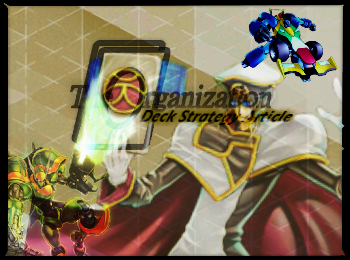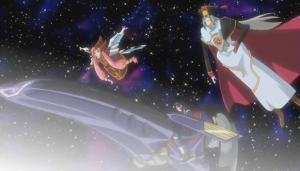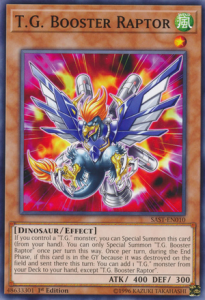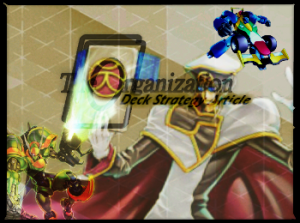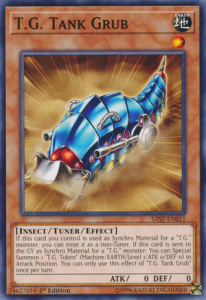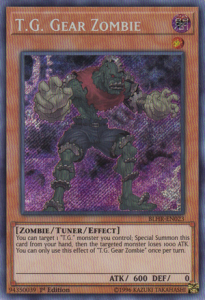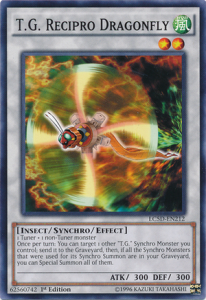Let’s work through building a TCG variant of T.G. from ground zero to let this cool theme shine.
Introduction:
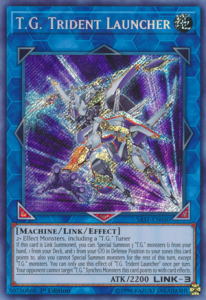 The T.G. archetype, short for Tech Genius, that debuted near the end of the Synchro era is one of my favorite Synchro-centric archetypes. Featuring 12 different types among its archetype members, it is one of the few synchro decks truly capable of continuing to shine, even under certain floodgate trap cards such as There Can Only Be One. While the unique mechanic it brought to the table was an archetype centered around Accel Synchro Summons and Delta Accel Synchro summons, or making bigger Synchro monsters by only using other Synchro monsters as material. Besides these unique Synchro capabilities, this theme has also recieved a ton of support recently, with support in Savage Strike and Battles of Legend: HEROs Revenge. So let’s explore the new possibilities opened to the theme.
The T.G. archetype, short for Tech Genius, that debuted near the end of the Synchro era is one of my favorite Synchro-centric archetypes. Featuring 12 different types among its archetype members, it is one of the few synchro decks truly capable of continuing to shine, even under certain floodgate trap cards such as There Can Only Be One. While the unique mechanic it brought to the table was an archetype centered around Accel Synchro Summons and Delta Accel Synchro summons, or making bigger Synchro monsters by only using other Synchro monsters as material. Besides these unique Synchro capabilities, this theme has also recieved a ton of support recently, with support in Savage Strike and Battles of Legend: HEROs Revenge. So let’s explore the new possibilities opened to the theme.
The crux of the new support is the new in-theme Link monster that aims to jumpstart the infamous Synchro Summons that the theme is known for. T.G. Trident Launcher is a Link 3 monster that can Special Summon 3 other T.G. monsters, 1 each from hand, deck and GY, whenever it is Link Summoned. Despite being weak to just about every handtrap under the sun, this one card can truly turboboost your strategy into overdrive if you get the chance to Synchro Summon him without disruption. So as this is the key card, we need to design our deckbuild to facilitate him arriving to the field in all of his glory.
First, let’s discuss the required materials and why this theme might be so tricky to build for the TCG. Trident can be summoned using any 2+ effect monsters as long as one of your materials is a T.G. Tuner. This is awesome in a ton of ways, but most of all, you are probably aware that this theme was designed with the Synchro Summoning support Link monster in mind, Crystron Glassfiber (YGOrg Translation). Released in Link Vrains Pack 1 to the OCG, TCG players have been waiting for what seems like ages for the card to be imported to the TCG. Since Glass can be Link Summoned using any tuner and then could bring out a T.G. tuner when it is Link Summoned, Trident was a quick jump away to begin the strategy with your Synchro-enabled board. In the TCG, we do not have the luxury of running all of the various engines that can abuse Glassfiber, so this is where the challenge lies for deckbuilders looking to take on T.G.

What are our options for outside help?
When approaching a deckbuilding challenge such as this one, we need to first establish our core cards that will help enable our main plays. In this case, we need to be able to summon Launcher as often as possible. That being said, we do have a couple of neat options to consider, so let’s walk through their advantages.
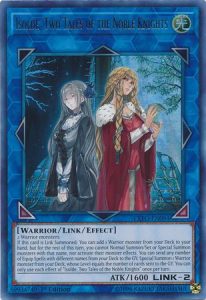 First up, let’s talk about the Warrior engine. Since we have another Link monster that can summon a T.G. Tuner from the deck – Isolde, Two Tales of the Noble Knights. Since Isolde can send any two equips to the GY to Special Summon Striker from the deck, all we need would be to run Warrior enablers such as Junk Forward, Neo-Space Connector and Neo-Spacian Aqua Dolphin, or a HERO engine featuring Destiny HERO Malicious and Armaggedon Knight or Dark Grepher. As you’ll notice – this build gets bloated extremely quickly. With so many cards that are just pieces of the engine, you can often find yourself in a position where you just don’t have that T.G. monster in hand to be able to even benefit off of Trident.
First up, let’s talk about the Warrior engine. Since we have another Link monster that can summon a T.G. Tuner from the deck – Isolde, Two Tales of the Noble Knights. Since Isolde can send any two equips to the GY to Special Summon Striker from the deck, all we need would be to run Warrior enablers such as Junk Forward, Neo-Space Connector and Neo-Spacian Aqua Dolphin, or a HERO engine featuring Destiny HERO Malicious and Armaggedon Knight or Dark Grepher. As you’ll notice – this build gets bloated extremely quickly. With so many cards that are just pieces of the engine, you can often find yourself in a position where you just don’t have that T.G. monster in hand to be able to even benefit off of Trident.
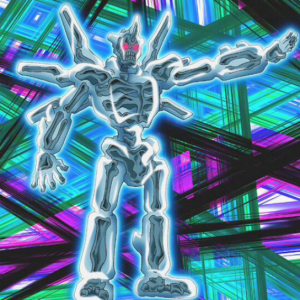 Next, there is the Zombie engine. Since both T.G. Gear Zombie and T.G. Metal Skeleton are DARK Zombies with 0 DEF, there is a ton of synergy with existing zombie support like Unizombie and Shiranui Solitaire. Additionally, Zombies have great synergy with Synchro monsters, as you can probably tell through past iterations of the type being abused for Synchro loops since the beginning. The last benefit to this build is that even if you only draw pieces of your Zombie engine, Zombies can function alone for a while until you can draw or search into your T.G. pieces.
Next, there is the Zombie engine. Since both T.G. Gear Zombie and T.G. Metal Skeleton are DARK Zombies with 0 DEF, there is a ton of synergy with existing zombie support like Unizombie and Shiranui Solitaire. Additionally, Zombies have great synergy with Synchro monsters, as you can probably tell through past iterations of the type being abused for Synchro loops since the beginning. The last benefit to this build is that even if you only draw pieces of your Zombie engine, Zombies can function alone for a while until you can draw or search into your T.G. pieces.
The last option is focusing around the eternal combo builds – decks that start out with an initial Ib, the World Chalice Justicar before transitioning into a long chain of summons, searching basically any tuner you would want using Omni Dragon Brotaur and Reprodocus. This combo can currently be tooled to an FTK, so if you are switching the build to use T.G.s instead, you are missing out on a valuable opportunity. Thus, this option is also out.
So where does that leave us? Unfortunately we don’t have a solid outside option to turn to without drawbacks so let’s try to stick to a core build. We’ll just build around that as it’s our best option to make this archetype function at top speeds.
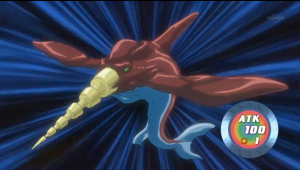
Finding a Pure Core:
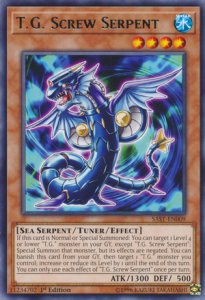 Now that we’ve identified pure as our direction, we need to begin by selecting the appropriate T.G. tuners to begin our deck. Far and away the best available option, T.G. Screw Serpent should be the first card added to your list. Not only does a summon of Screw also get you a monster from the GY, but it is a level 4 tuner which will be important later. The next tuner to build around is T.G. Tank Grub, another new tuner introduced in Savage Strike. Since it can also be treated as a non-tuner for a Synchro Summon and it summons a token after being used for a Synchro Summon, he is versatile enough to fill multiple roles for our build. To round out our tuner count, let’s also include the two tuners that can Special Summon themselves from the hand: T.G. Striker and T.G. Gear Zombie. This will give us a bit more oompf to work your Trident onto the field as consistently as possible.
Now that we’ve identified pure as our direction, we need to begin by selecting the appropriate T.G. tuners to begin our deck. Far and away the best available option, T.G. Screw Serpent should be the first card added to your list. Not only does a summon of Screw also get you a monster from the GY, but it is a level 4 tuner which will be important later. The next tuner to build around is T.G. Tank Grub, another new tuner introduced in Savage Strike. Since it can also be treated as a non-tuner for a Synchro Summon and it summons a token after being used for a Synchro Summon, he is versatile enough to fill multiple roles for our build. To round out our tuner count, let’s also include the two tuners that can Special Summon themselves from the hand: T.G. Striker and T.G. Gear Zombie. This will give us a bit more oompf to work your Trident onto the field as consistently as possible.
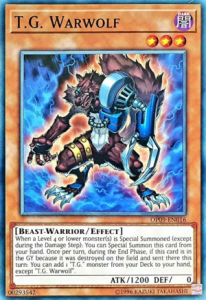 Speaking of consistency, let’s talk about the other summoning capabilities that T.G. offers among its non-tuner cast. T.G. Warwolf can be Special Summoned from the hand anytime a level 4 or lower monster is Special Summoned, so let’s get him into the mix. Next up, T.G. Booster Raptor can summon itself from the hand while you control a T.G. monster and T.G. Drill Fish can summon itself from the hand if you control only T.G. monsters. This gives us a nice initial cast of T.G. monsters that offer various forms of Special Summoning, ensuring our best chances of getting the Geniuses we need to unlock Trident. But you should also notices that of all the monsters I’ve listed so far, 4/7 of them are Level 1! This seems like a great opportunity to define another build option.
Speaking of consistency, let’s talk about the other summoning capabilities that T.G. offers among its non-tuner cast. T.G. Warwolf can be Special Summoned from the hand anytime a level 4 or lower monster is Special Summoned, so let’s get him into the mix. Next up, T.G. Booster Raptor can summon itself from the hand while you control a T.G. monster and T.G. Drill Fish can summon itself from the hand if you control only T.G. monsters. This gives us a nice initial cast of T.G. monsters that offer various forms of Special Summoning, ensuring our best chances of getting the Geniuses we need to unlock Trident. But you should also notices that of all the monsters I’ve listed so far, 4/7 of them are Level 1! This seems like a great opportunity to define another build option.
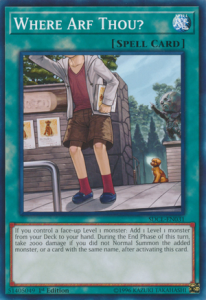 Since so many of these monsters are Level 1 and so many of them include effects to Special Summon, it seems like a perfect fit to also include the catch-all Level 1 searcher – Where Arf Thou?. All you need is to control a Level 1 monster to add any other from your deck to the hand. So let’s lean into this more and give the deck more Level 1 monsters that can be inherently summoned. The first is Jester Confit, a Level 1 that has no restriction on its summoning from the hand, except that you can only control 1 Jester. This is perfect, as you can summon jester, search out Tank Larva with Arf, then if you have other T.G. in your hand to go for Trident, you have the option of doing so! Another Level 1 with a similar ability just released this past weekend with the launch of Chaos Impact is Bonze Alone. Unlike Jester, this does have the restriction that you control no monsters (and the obligation that you use him to Link Summon Linkuriboh immediately after searching with Arf), but it is another inherent Level 1 Special Summon that leads towards your all-important Trident Summon.
Since so many of these monsters are Level 1 and so many of them include effects to Special Summon, it seems like a perfect fit to also include the catch-all Level 1 searcher – Where Arf Thou?. All you need is to control a Level 1 monster to add any other from your deck to the hand. So let’s lean into this more and give the deck more Level 1 monsters that can be inherently summoned. The first is Jester Confit, a Level 1 that has no restriction on its summoning from the hand, except that you can only control 1 Jester. This is perfect, as you can summon jester, search out Tank Larva with Arf, then if you have other T.G. in your hand to go for Trident, you have the option of doing so! Another Level 1 with a similar ability just released this past weekend with the launch of Chaos Impact is Bonze Alone. Unlike Jester, this does have the restriction that you control no monsters (and the obligation that you use him to Link Summon Linkuriboh immediately after searching with Arf), but it is another inherent Level 1 Special Summon that leads towards your all-important Trident Summon.
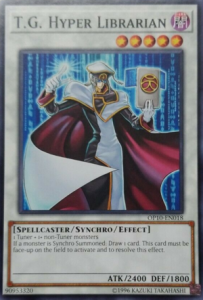 Now that we’ve defined a T.G. core, a support engine of Level 1 monsters and the goal of getting to Trident Launcher as soon as possible, let’s talk about the Synchro monsters that this theme claims with pride. T.G. Hyper Librarian, best known for its Plant Synchro days, is an excellent option that lets you draw a card every time you Synchro Summon. Hyper is a great way to regain any card advantage lost for making a Synchro summon, so any additional plusses off your other Synchro Summons are just bonus. Next up is the Synchro Monster debuting alongside Trident – T.G. Star Guardian. This is the first Synchro Tuner of the archetype, and should be your first to create. Not only does it recycle one of your T.G. monsters back from your GY when it is Special Summoned (think Synchro and re-used by Trident), but it also lets you special summon a T.G. from your hand.
Now that we’ve defined a T.G. core, a support engine of Level 1 monsters and the goal of getting to Trident Launcher as soon as possible, let’s talk about the Synchro monsters that this theme claims with pride. T.G. Hyper Librarian, best known for its Plant Synchro days, is an excellent option that lets you draw a card every time you Synchro Summon. Hyper is a great way to regain any card advantage lost for making a Synchro summon, so any additional plusses off your other Synchro Summons are just bonus. Next up is the Synchro Monster debuting alongside Trident – T.G. Star Guardian. This is the first Synchro Tuner of the archetype, and should be your first to create. Not only does it recycle one of your T.G. monsters back from your GY when it is Special Summoned (think Synchro and re-used by Trident), but it also lets you special summon a T.G. from your hand.
F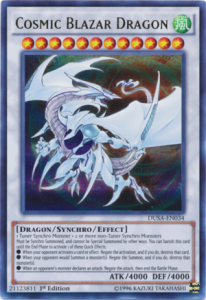 rom the original batch of support comes the other Synchro tuner for the theme – T.G. Wonder Magician. This is more of a niche option to clear out an opponent’s card while going for your plays, but it still can work great nonetheless! The last Synchro, now that we have the new support, can FINALLY be summoned for the first time with in-archetype support cards – T.G. Recipro Dragonfly. This level 2 Synchro seems weird at first, but when you start using his effect on a Star Guardian to swap it out for a Wonder, drawing extra cards along the way, you can start to see how it can play a neat combo role. The other essential role it plays is that it acts as the last two levels for the Synchro Summon of the true boss monster of this theme – Cosmic Blazar Dragon.
rom the original batch of support comes the other Synchro tuner for the theme – T.G. Wonder Magician. This is more of a niche option to clear out an opponent’s card while going for your plays, but it still can work great nonetheless! The last Synchro, now that we have the new support, can FINALLY be summoned for the first time with in-archetype support cards – T.G. Recipro Dragonfly. This level 2 Synchro seems weird at first, but when you start using his effect on a Star Guardian to swap it out for a Wonder, drawing extra cards along the way, you can start to see how it can play a neat combo role. The other essential role it plays is that it acts as the last two levels for the Synchro Summon of the true boss monster of this theme – Cosmic Blazar Dragon.
Blazar Dragon is pretty awesome. It can negate a summon, a card or effect, or an attack once per turn by banishing itself. This is the disruption that T.G. offers, at least off of its initial Trident summon, since it can be Double Accel Synchro Summoned using T.G. Synchro Tuner + Hyper Librarian + Recipro Dragonfly during your opponent’s Main Phase by the effect of either of your T.G. Synchro Tuners. While Cosmic is still able to be tributed away by a Kaiju, there is not much else that can stop him. So with a worthy boss monster, a consistency engine, and a diverse archetype I think we have enough to be able to build a full deck. Let’s checkout the decklist!
Decklist:
Click to view the Interactive Decklist in the Official Card Database.
Spoiler
Monsters: 25
||| T.G. Tank Grub
||| T.G. Screw Serpent
||| T.G. Striker
||| T.G. Gear Zombie
||| T.G. Warwolf
||| T.G. Drill Fish
|| T.G. Booster Raptor
|| Bonze Alone
||| Jester Confit
Spells: 15
||| Where Arf Thou?
||| Fire Formation – Tenki
| Whitefish Salvage
| Reinforcement of the Army
||| Called by the Grave
| Monster Reborn
||| Pot of Desires
Extra Deck:
| Cosmic Blazar Dragon
| T.G. Blade Blaster
|| T.G. Hyper Librarian
|| T.G. Star Guardian
| T.G. Recipro Dragonfly
| T.G. Wonder Magician
| Crystron Quariongandrax
| Borreload Savage Dragon
| Cyberse Quantum Dragon
| Formula Synchron
|| T.G. Trident Launcher
| Linkuriboh
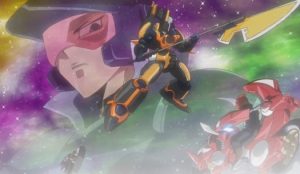
“He seems to be very unreliable, but he might have incredible potential”
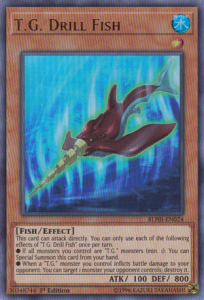 I cannot stress enough – this deck is 100% not at full power in the TCG due to the lack of the Crystron link. But that does not mean that this deck is dead in the water. Quite the opposite actually – it has a ton of combo potential through a successful Trident Launcher effect. The difficulty, and the reason for so much deck optimization theory earlier in this article, is that you have to balance maximizing his ability to trigger with your ability to still win the duel after pouring resources into him. The first thing you should notice is the mandatory 3 copies of Called by the Grave in the main deck – it is absolutely essential due to Tridents inability to survive hand traps. The only other option I could suggest as an alternative would be to also try and find room for a Sky Striker engine, as Sky Striker Maneuver – Eagle Booster can be effective at protecting him as well.
I cannot stress enough – this deck is 100% not at full power in the TCG due to the lack of the Crystron link. But that does not mean that this deck is dead in the water. Quite the opposite actually – it has a ton of combo potential through a successful Trident Launcher effect. The difficulty, and the reason for so much deck optimization theory earlier in this article, is that you have to balance maximizing his ability to trigger with your ability to still win the duel after pouring resources into him. The first thing you should notice is the mandatory 3 copies of Called by the Grave in the main deck – it is absolutely essential due to Tridents inability to survive hand traps. The only other option I could suggest as an alternative would be to also try and find room for a Sky Striker engine, as Sky Striker Maneuver – Eagle Booster can be effective at protecting him as well.
 The craziest thing that I learned about T.G. when playtesting and researching the theme is that they are a hard combo deck that actually has good options to keep playing the duel even after their combo resolves. Sure, you may rely on Trident for your first chain of plays, but once you have that GY setup, getting your Star Guardian back from the GY becomes much more potent, access to other Synchro monsters gives you more disruption and removal, and the game becomes much easier. The theme really does just need that initial push to get up to speed with a few Synchro Summons under its belt, then it can perform admirably, admittedly in a more casual environment than competitive. Thus the Aitsu reference in the title of this section – it truly has potential despite appearing unreliable at first glance.
The craziest thing that I learned about T.G. when playtesting and researching the theme is that they are a hard combo deck that actually has good options to keep playing the duel even after their combo resolves. Sure, you may rely on Trident for your first chain of plays, but once you have that GY setup, getting your Star Guardian back from the GY becomes much more potent, access to other Synchro monsters gives you more disruption and removal, and the game becomes much easier. The theme really does just need that initial push to get up to speed with a few Synchro Summons under its belt, then it can perform admirably, admittedly in a more casual environment than competitive. Thus the Aitsu reference in the title of this section – it truly has potential despite appearing unreliable at first glance.
Alternative Tech Options:
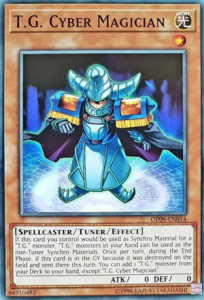 T.G. Monster Options:
T.G. Monster Options:
- T.G. Cyber Magician – Sharing Level 1 tuner status with Tank Grub and Gear Zombie, this is just the worst option of the three. While its hand Synchro capability is cool, it also requires that you run the next monster on this list t0 be useful.
- T.G. Rush Rhino – Oh how the glorious have fallen. Back in the day, Rhino was great as a floating beater. But nowadays, he is quite outclassed. The only reason to run this guy would be to be able to justify Cyber Magician, or if you want to unlock Borreload Savage Dragon off of a Screw Serpent summon.
- T.G. Catapult Dragon – Believe it or not, Catapult Dragon actually have more of a use in the deck now. Who would have though that Rush would trade places as a tech in T.G. for this. Since you are running so many tuners that could potentially be difficult to get out of your hand early, this can be used to jumpstart weaker hands. The bigger benefit however is that he is a Level 2 non-tuner, so you could use him to get access to new Synchro level combinations for during your opponent’s turn with one of your Synchro Tuners.
- T.G. Metal Skeleton – The in-theme protection for Trident is an option as another Level 2 non-tuner. While he can work in a Zombie build, he just struggles to make a good impact on the duel outside of that niche case, which is why catapult ranks above him for Level 2 options.
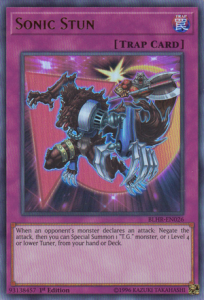 T.G. S/T Support:
T.G. S/T Support:-
- TGX3-DX2 – While slow due to being a Trap card, you have plenty of ways to get 3 T.G. monsters to GY early, opening up a free +1 on the subsequent turn. Running this would also let you run less copies of your key monsters such as Trident or Hyper Librarian, opening up more Synchro tech options for your Extra Deck.
- TG1-EM1 – The trap Creature Swap – this card was amazing in its day. While it has somewhat lost its luster as the game has evolved, it is still a unique disruption option that other decks don’t have in their arsenal.
- Sonic Stun – While a negated attack doesn’t seem all too cool, the better part of this card is that it can search any T.G. or Tuner monster from your deck. I’m hoping someone can find a cool use for this card even out the archetype, but this is here as an option as a free summon from the deck can always find a use somewhere.
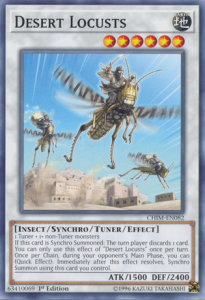 Synchro Support Options
Synchro Support Options
- Desert Locusts – As Tank Grub makes a Lv1 token when used in a Synchro Summon, you can make a Level 6 Synchro easily on your opponents turn using the Token and Star Guardian. This would then give you a bit more Synchro flexibility, but only if you could fit in other options to your Extra deck to pair with it.
- Hop Ear Squadron – Leave a Warwolf on your field? Turn it into a Star Guardian during the opponent’s turn, letting you continue Synchro Summons during the opponent’s turn!
- Red Blossoms from Underroot – As you are running Synchros and Links, you can use this card to get back fallen comrades. It is also a Level 1 that can be Special Summoned from the hand, adding extra potential value!
- Starlight Junktion – Spin your opponent’s card when you perform a Synchro during their turn! This can also be paired with Unknown Synchron or Jet Synchron as additional Lv1 tuners that can SS themselves.
Upcoming Support:
 Even if you don’t think T.G. have any potential right now, there is still more direct and undirect support to come for the theme in the future. The first card has been covered multiple times now, but that would be Crystron Glassfiber (YGOrg Translation). Since it can bring out any T.G. Tuner from the deck, you can build the main deck completely differently, running a minimal number of T.G. tuners. This also gives you a considerable advantage lead early in the game if you make Trident off of a single normal summon like Righty Driver. But since this card has been released to the OCG in November 2017 with no TCG release date in sight, I wouldn’t get my hopes up that this is coming anytime soon.
Even if you don’t think T.G. have any potential right now, there is still more direct and undirect support to come for the theme in the future. The first card has been covered multiple times now, but that would be Crystron Glassfiber (YGOrg Translation). Since it can bring out any T.G. Tuner from the deck, you can build the main deck completely differently, running a minimal number of T.G. tuners. This also gives you a considerable advantage lead early in the game if you make Trident off of a single normal summon like Righty Driver. But since this card has been released to the OCG in November 2017 with no TCG release date in sight, I wouldn’t get my hopes up that this is coming anytime soon.
On the other hand, a new T.G. Synchro monster was recently revealed for an upcoming product. Check out our article on the reveal here. Shooting Star Dragon T.G. – Expansion (YGOrg Translation) gives the theme a new Level 10 Synchro that provides a better alternative for Blade Blaster that offers monster targeting protection and attack negation. It’s another option for the extra deck that doesn’t offer anything too revolutionary, and while we also don’t have an estimated time of release for this card into the TCG, it is nevertheless supercool to see future support for T.G. down the road.
Conclusion:
The T.G. theme may not be at its final form yet, but it definitely can still pack a punch through its unique combination of combo potential, delta accel synchro summoning, and extended plays after the first major combo is completed. This is a stark difference from other Synchro spam decks like Synchron that can only go off once, and doesn’t have much left in the tank if the initial big play is disrupted or shut down. Also, I hope you found it helpful to walk through a sample process for building a deck like this where there isn’t a discovered ‘best build’ yet – feel free to apply a similar methodology to your own deckbuilding and you’ll find that you can build some pretty creative decks!
Reminder, I also take suggestions for future CDS articles! I really want to see some input from you! If you wish to see a CDS article about the archetype, theme, or strategy you love, feel free to private message me on the YGOrg Discord server, the YGOrganization Forums, or just post a comment in response to this article on our Facebook page with your ideas to keep under consideration! On most YGO-related communities my username is Quincymccoy, so feel free to reach out.

